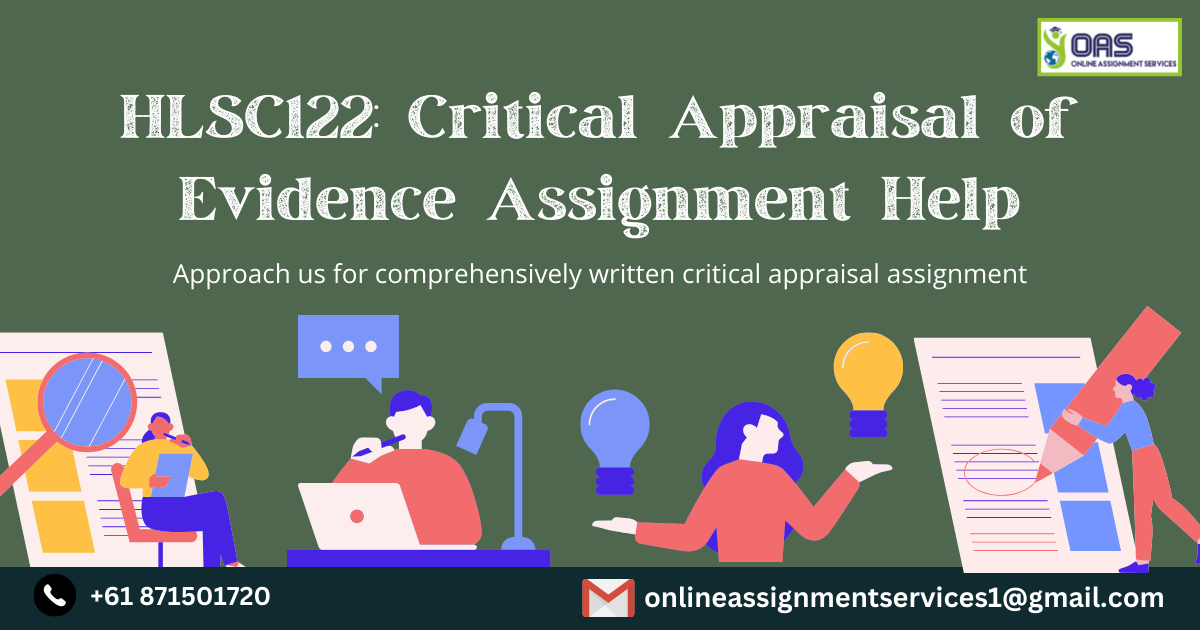HLSC122: Critical Appraisal of Evidence Assignment Help

Question
HLSC122: In this assignment for Australian Catholic University, students are provided with two health-related research studies which they are supposed to critically appraise based on their understanding regarding evidence-based critical analytical skills. A critical appraisal checklist is provided to the student to write this assignment.
One of the two research studies provided to the students is the “Effects of virtual reality on pain, fear, and anxiety during blood draw in children aged 5–12 years old: A randomized controlled study” published in the Journal of Clinical Nursing (ÖzalpGerçeker, G., Ayar, D., Özdemir, E. Z., &Bektaş, M, 2020).
The second case study is “Symptom Management to alleviate thirst and dry mouth in critically ill patients: a randomized controlled trial” published in the Australian Critical Care (Zhang, W., Gu, Q., Gu, Y., Zhao, Y., & Zhu, L, 2022).
Solution
Our experts have written the critical appraisal solution comprehensively, which incorporates the following sections: Identifying the Clinical Problem and Research Question, and Critical Appraisal for the two research papers, followed by an Appraisal summary, and Methodological rigor.
Identifying the Clinical Problem and Research Question
This section highlights the clinical problem central to the study along with focussing on what the aim of the research was. Our experts have comprehensively written this section to orient the reader to the issue and provide a foregrounding to the literature, gaps in literature as well as other aspects of the research. The clinical problems of both articles have been analyzed in separate sub-sections of this assignment:
Article 1:
The first article is authored by Zhang et al (2022). This article mainly focuses on the problem of thirst that is often apparent in the case of critically ill patients. Thirst is also associated with the high prevalence, intensity and increasing distress among patients.
Article 2:
Second article is authored by Özalp Gerçeker et al. (2020). The aim of this article is to evaluate the effect of Virtual Reality (VR) methods on blood draw procedure related pain, fear and anxiety among children aged 5-12 years.
We have provided only 50% of the solution here. To know more, WhatsApp us at +447956859420.
Critical Appraisal
This constitutes the main critical appraisal of the two articles. Here all the questions from the critical analysis checklist are answered by our experts to provide a holistic view of how reliable and appropriate the research study is. Our experts have highlighted all the important strengths and limitations of research papers. This section also discusses the critical appraisal of the two studies separately.
Article 1: Zhang et al (2022)
This study is clearly focused on a particular research problem and also assesses the outcome of the interventions. The research aim and research question was clearly aimed towards the study population (critically ill patients), provide the clear details about the interventions to be used, provide a comparison between the experiment and control groups and also measured the outcomes. Thus, researchers conducted the randomised control trial with experimental and control group and included 61 patients for 3 days of study. The research problem is considered to be highly significant because the problem of thirst is common among critically ill patients. Hariton & Locascio (2018) informed that RCTs are considered to be the gold standard for analysing effectiveness of interventions or treatment, thus the comprehensive identifications of results is associated with quality and reliability of study findings.
Article 2: Özalp Gerçeker et al. (2020)
Study conducted by Özalp Gerçeker et al. (2020) provides the clear identification of aims and research problem. Researchers identify the children often have fear from the painful treatments and procedures. Thus, analysing the effect of VR on influencing pain levels could be interesting to note. This article identifies the research gap, stating that there are limited or no understanding about the impact of VR and its effect on ‘fear’ that children often experience during painful procedures. Secondly researcher also provides the clear details about the interventions, population groups as well as outcomes of the study were appropriately measured.
Need the complete critical appraisal for the two research papers? Let us help you. Reach out today- onlineassignmentservices1@gmail.com.

Appraisal Summary
This section provides a concluding summary and significant findings from the critical analysis of both the studies. You can read a snippet of answers written by our experts below.
Article 1:
Zang et al (2020) adopted the linear mixed model of analysis to analyse the intensity of thirst. Researcher used the comprehensive analysis approach to present the results, with pre-test to post-test results. Zang et al (2020) also provide the p value that is importantly associated with validity of results.
Article 2:
Özalp Gerçeker et al. (2020) used the linear regression analysis to explain and evaluate the self report pain and anxiety among children undergoing painful interventions. Author provides the p value and also the comprehensive statistical analysis of the pain scores collected from participants.
Confused about the reliability of the two research paper? We can help, just WhatsApp us at +447700174710.
Methodological Rigour
In this last section, our experts have remarked on the methodology of the study. An extensive knowledge and critical analysis of how the research was undertaken and whether it was consistent with the research aim of the study is presented here.
Article 1:
Blinding was an important feature of the trial as the participants and researchers were blind to allocation and intervention. This was done to reduce or to prevent selection biases. For example, in Zang et al (2020), one of the research nurses collected the thirst score from the patients, while the second nurse wrote the codes on envelopes of the patient, so that every patient has the equal opportunity. Scholars have also argued that blinding is an important feature of RCT that support in maximising the validity of study findings and provides the highest possible valid results (Monaghan et al., 2021). Although the study group were not equal in terms of demographic characteristics, as 21 participants were females, while 40 participants were males.
Article 2:
Methodology of the study included blocked randomisation with concealed allocation with the help of computer program. Participants of the study were not blinded to the intervention. Monaghan et al. (2021) the lack of participant blinding can lead to performance or reporting biases. However, researcher mentions that children and parents were blind to each other’s scores. However, researcher D was not blinded, which could further affect the validity of results because of the personal biases of the researcher.
Interested in reading more about the evaluation of the methodologies for both studies? Wait no more, and call us at +61 871501720 today.

